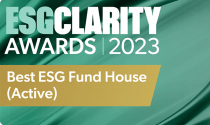
The avid follower of WHEB’s investment strategies will have noticed a marked increase in exposure to so-called “Big Pharma” stocks with CSL, Astra Zeneca and Genmab in our main strategy and Novo Nordisk additionally in our European Fund. Just a few years ago, WHEB had only minimal exposure for good reasons so what has changed?
A look back through the history of big pharma
Big pharma used to be a dirty word to use. Scandals around Turing Pharma (CEO Michael Shkreli’s decision to hike HIV medication Daraprim’s price by 5455% price overnight in 2015)1 , Purdue Pharma (the Sackler family fuelling the opioid epidemic with OxyContin from 1996-2019)2, and Mylan Pharma (price gouging of the EpiPen drug delivery system by ~400% from 2009-2016)3 are well-known but formed only the tip of the iceberg.
Until the later mid 2010s, big pharma used to be characterised by its aggressive promotion of drugs to doctors via visiting sales reps handing out free samples and gifts. Their remuneration largely depended on the number of prescriptions those drugs recorded within their assigned territory.4 Looming patent cliffs for blockbuster drugs, ie the end of patent protection and opening up for substantially cheaper generic equivalents, pushed pharma companies to prioritise drug development to create mild variations of their existing drugs. These were typically small variations in drug composition or modest changes to delivery mechanisms. In one case the change was simply adding a stripe to a pill. This would then result in the application for a patent extension to preserve exclusivity for longer. A study covering 2005-2015 showed that 70% of the nearly 100 bestselling drugs in the US had extended their exclusivity at least once and 78% of the drugs associated with new patents were for existing drugs rather than a new treatment.5 On top of all this hefty annual price increases were common-place resulting in some cases of outright price gouging thanks to the lengthy exclusivity and a flawed price negotiation mechanism. Needless to say, WHEB stayed well clear of this space during those years.
Big pharma today is different
Big pharma is different today. No, they have not become angels working for the greater good of all (even though Astra Zeneca’s commitment to sell its Covid vaccine at cost for the first year was remarkable). The change was driven by a combination of greater public and political scrutiny on drug pricing in the US and a fundamental shift in technological focus from “me-too” small molecule drug development to innovative new biologic (or large molecule) research.
The political and regulatory focus on drug pricing has not stopped since the famous tweet by Hillary Clinton in 20166 which sent biotech and pharma stocks tumbling alike. Even though very little concrete changes happened thereafter, the Damocles sword was firmly in place instilling a new-found discipline into the pharma industry to limit annual price increases to below 10% in order to avoid greater scrutiny.7 The recent Inflation Reduction Act (IRA) legislation from 2022 is the first concrete step in the US to empower the government’s national health insurance program Medicare to “negotiate” (or rather dictate) prices for 10 of the 50 drugs that represent the highest cost to the programme from 2026 onwards.
The other important development was in terms of a change of focus in therapeutic areas and underlying science towards typical biotech specialities: oncology, immunology, rare diseases. And this was triggered partially by the regulatory changes. Biotech drugs are more sophisticated, making use of the human genome, monoclonal antibodies and gene therapies to name a few and therefore generally demand a substantially higher price. They allow pharma companies to move into less crowded, highly impactful therapies and once the patent expires their generic equivalent, the biosimilars, are actually much more complicated to produce than small molecule, chemical-based generics. This means that the price protection can last for longer.8 Even though price gouging in the form of unreasonable annual price increases has mostly ceased, there exists the new risk of an unreasonably high initial drug price at launch. For that reason, WHEB has developed its own drug pricing checklist which we evaluate before a potential investment.
WHEB’s approach
While most of “Big pharma” had been a no-go area for WHEB’s strategy in the past, we have recognised the substantial improvement in the drug pipeline to much more impactful therapies, many from large molecules. In order to evaluate the company’s approach to pricing we developed a drug pricing checklist which we run by the company to establish their pricing transparency and internal processes, people in charge, patient assistance schemes, affordability assessments by independent parties, annual price increases etc. Quite often, the willingness of the company to engage with us on these points is quite telling in itself.
In addition, we extensively use our access to expert networks to further our understanding on the efficacy and prospects of therapies and the market approach of their owners. We now have the following holdings in our strategies which all achieve strong scores (mostly >30% which is rare) from our impact engine9:
- Astra Zeneca: A leader in oncology, respiratory, inflammation and autoimmunity, cardiovascular and metabolic disease, and infection and neuroscience with a rich pipeline for new indications.
- CSL: A leader in plasma-based therapies often addressing rare diseases in immunology, haematology or respiratory.
- Genmab: A leading-edge primarily oncology antibody development powerhouse partnering up with big pharma for commercialisation with key successes in multiple myeloma (blood cancer) treatment, DLBCL (cancer of the lymphatic system), thyroid eye disease, and others.
- Novo Nordisk (in European Strategy): Market leader in diabetes and obesity treatment with a new ground-breaking type of GLP-1 (a gut hormone) variation
Our search for strongly impactful big pharma is certainly not over but we also remain vigilant of pharma companies and their approach to pricing and access.
Sign up here to receive our monthly and quarterly commentaries in your inbox.
1 https://www.fiercebiotech.com/biotech/why-would-martin-shkreli-hike-an-old-drug-price-by-5000-only-a-moron-would-ask
2 https://www.statnews.com/2019/12/03/oxycontin-history-told-through-purdue-pharma-documents/
3 https://money.cnn.com/2016/08/29/investing/epipen-price-rise-history/index.html
4 https://www.forbes.com/sites/dalearcher/2013/12/26/the-dark-side-of-big-pharma-2/?sh=5f635c159a22
5 Robin Feldman, “May your drug price be evergreen,” Journal of Law and the Biosciences 5 (3) (2018): 590–647, available at https://academic.oup.com/jlb/article/5/3/590/5232981
6 https://www.fiercepharma.com/pharma/will-u-s-act-drug-prices-hillary-s-latest-tweet-raised-specter-and-investors-panicked
7 https://aspe.hhs.gov/reports/prescription-drug-price-increases
8 https://www.barrons.com/articles/big-pharma-biotech-stocks-51655417765
9 https://www.whebgroup.com/investing-for-impact/how-we-invest/our-methodology




